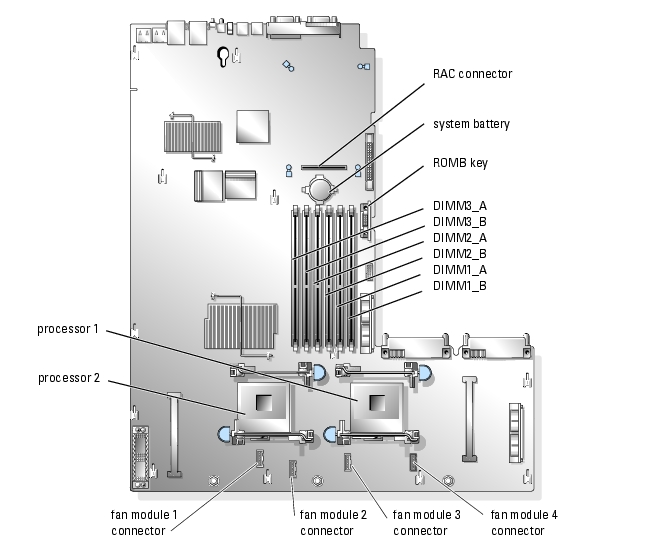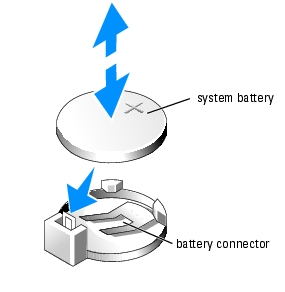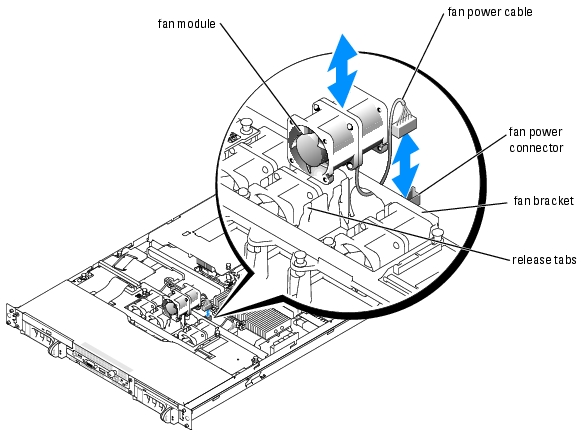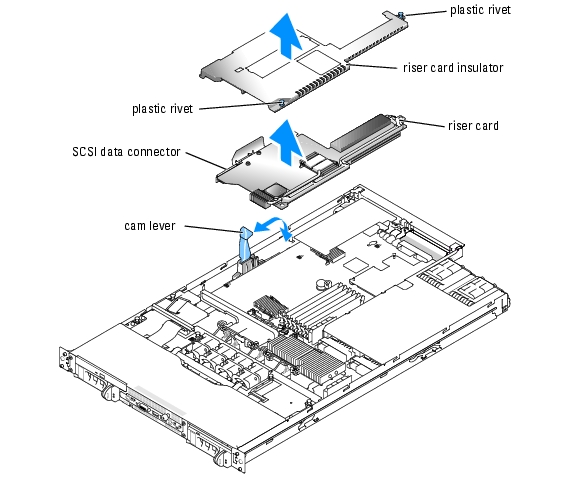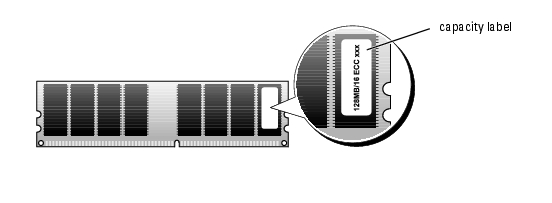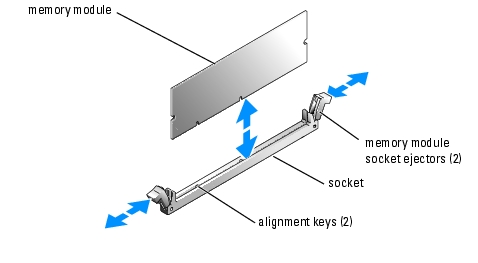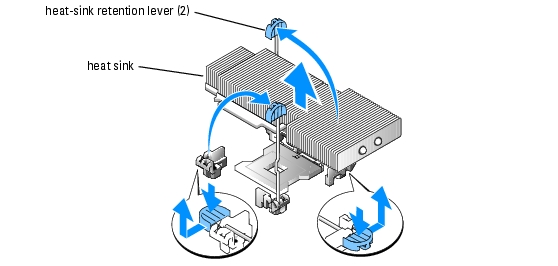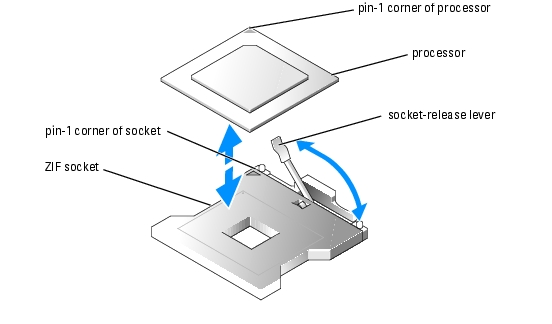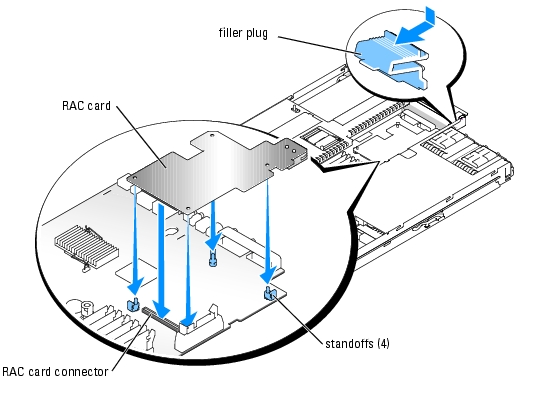Back to Contents Page
Installing System Components
Dell™ PowerEdge™ 1850 Systems Installation and Troubleshooting Guide
 System Board Components
System Board Components
 System Battery
System Battery
 Fans
Fans
 Power Supplies
Power Supplies
 Expansion Cards
Expansion Cards
 Riser Card
Riser Card
 System Memory
System Memory
 Processor
Processor
 Installing a RAC Card
Installing a RAC Card
This section describes how to install the following system components:
- System battery
- Cooling fans
- Power supplies
- Expansion cards
- Riser card
- System memory
- Processors
- RAC card
For information on activating the optional integrated RAID controller, see "Activating the Optional Integrated RAID Controller" in "Installing Drives."
System Board Components
When installing and replacing system board components, use Figure 6-1 to locate the components.
Figure 6-1. System Board Components and Connectors
System Battery
Replacing the System Battery

|
CAUTION: Only trained service technicians are authorized to remove the system cover and access any of the components inside the system. See your Product Information Guide for complete information about safety precautions, working inside the computer, and protecting against electrostatic discharge. |
- Enter the System Setup program and record the option settings on the System Setup screens.
See "Using the System Setup Program" in the User's Guide.
- Open the system. See "Opening the System" in Troubleshooting Your System."
- Remove the system battery. See Figure 6-2.
See Figure 6-1 to locate the system battery on the system board.
You can pry the system battery out of its connector with your fingers or with a blunt, nonconductive object such as a plastic screwdriver.
Figure 6-2. Replacing the System Battery
- Install the new system battery with the side labeled "+" facing up. See Figure 6-2.

|
NOTE: The side of the battery labeled "+" must face toward the open side of the battery socket. |
- Press the battery into the socket until it snaps into place.
- Close the system. See "Closing the System" in "Troubleshooting Your System."
- Enter the System Setup program to confirm that the battery operates properly.
- From the main screen, select System Time to enter the correct time and date.
- Re-enter any system configuration information that is no longer displayed on the System
Setup screens, and then exit the System Setup program.
- To test the newly installed battery, see "Troubleshooting the System Battery" in
"Troubleshooting Your System."
Fans
The four cooling fan modules provide cooling for the processors, memory modules, and expansion cards. Each fan module contains two fans.
Removing a Fan Module

|
CAUTION: Only trained service technicians are authorized to remove the system cover and access any of the components inside the system. See your Product Information Guide for complete information about safety precautions, working inside the computer, and protecting against electrostatic discharge. |
- Open the system. See "Opening the System" in Troubleshooting Your System."
- Disconnect the fan module's power cable from the system board. See Figure 6-3.
Figure 6-3. Installing and Removing a Fan Module
- While pressing the two release tabs on the fan bracket, lift the fan module out of the chassis.
See Figure 6-3.
Installing a Fan Module
- With the fan power cable facing towards the back of the system, route the fan power cable
through the opening in the fan bracket and insert the fan module into the fan bracket.
- Reconnect the fan power cable to the fan power connector on the system board. See
Figure 6-3.
- Close the system. See "Closing the System" in "Troubleshooting Your System."
Power Supplies
Removing a Power Supply

|
NOTICE: The system requires one power supply for the system to operate normally. The system is in the redundant mode when two power supplies are installed. Remove and replace only one power supply at a time in a system that is powered on. |

|
NOTICE: If only one power supply is installed, it must be installed in the left power supply bay (1). See Figure 6-4. |
To remove a power supply, press the latch at the left corner of the power-supply and slide the power supply straight out to clear the chassis (see Figure 6-4).
Figure 6-4. Installing and Removing a Power Supply
Replacing a Power Supply
- Slide the new power supply into the chassis until the power supply is fully seated and the
retention latch is engaged (see Figure 6-4).
- Connect the power cable to the power supply and plug the cable into a power outlet.
After installing a new power supply in a system with two power supplies, you must allow several seconds for the system to recognize the power supply and determine whether it is working properly. The power-on indicator will turn green to signify that the power supply is functioning properly
(see Figure 2-4).
Expansion Cards
Your system supports up to two full-height, half-length expansion cards, which are installed in connectors on a riser card. See Figure 6-5.
There are three types of riser cards:
- A standard riser card with one 3.3-V, 64-bit, 133MHz PCI-X expansion slot (Slot 1) and one 3.3-V, 64-bit, 100MHz PCI-X expansion slot (Slot 2).
- An optional riser card (when available) with one 3.3-V, 64-bit, 133-MHz PCI-X expansion slot (Slot 1), one 3.3-V, 64-bit, 100MHz PCI-X expansion slot (Slot 2), and support for RAID on motherboard (ROMB).
- An optional riser card (when available) that has one x4 lane width PCI-Express expansion slot (Slot 1), one x8 lane width PCI-Express expansion slot (Slot 2), and support for ROMB.

|
NOTE: PCI Slot 2 is the expansion slot closest to the power supply bays. See Figure 6-5. |
Installing an Expansion Card

|
CAUTION: Only trained service technicians are authorized to remove the system cover and access any of the components inside the system. See your Product Information Guide for complete information about safety precautions, working inside the computer, and protecting against electrostatic discharge. |
- Open the system. See "Opening the System" in Troubleshooting Your System."
- Lift the plastic expansion-card retainer adjacent to the empty slot. See Figure 6-5.
Figure 6-5. Installing and Removing Expansion Cards
- Remove the filler bracket on the slot you will be using.

|
NOTE: Keep this bracket if you need to remove the expansion card. Filler brackets must be installed over empty expansion card slots to maintain Federal Communications Commission (FCC) certification of the system. The brackets also keep dust and dirt out of the system and aid in proper cooling and airflow inside the system. |
- Insert the expansion card firmly into the expansion-card connector on the riser card until the
card is fully seated, being careful not to remove the riser card from the system board.

|
NOTE: Ensure that the expansion-card bracket is also inserted into the securing slot on the chassis's back panel. |
- Replace the expansion-card retainer. See Figure 6-5.
- Connect any internal or external cable(s) to the expansion card.
- Close the system. See "Closing the System" in "Troubleshooting Your System."
Removing an Expansion Card

|
CAUTION: See your Product Information Guide for complete information about safety precautions, working inside the computer, and protecting against electrostatic discharge. |
- Open the system. See "Opening the System" in Troubleshooting Your System."
- Disconnect any internal or external cable(s) that are connected to the expansion card.
- Lift the expansion-card retainer adjacent to the PCI slot. See Figure 6-5.
- Grasp the expansion card and carefully pull it away from the riser-card connector.
- If you are permanently removing the card, replace the metal filler bracket over the empty
card-slot opening.

|
NOTE: Filler brackets must be installed over empty expansion-card slots to maintain FCC certification of the system. The brackets also keep dust and dirt out of the system and aid in proper cooling and airflow inside the system. |
- Replace the expansion-card retainer.
- Close the system. See "Closing the System" in "Troubleshooting Your System."
Riser Card
To upgrade the riser card in your system, or to temporarily remove the riser card for access to the system board, follow the instructions in this section.
Removing the Riser Card

|
CAUTION: Only trained service technicians are authorized to remove the system cover and access any of the components inside the system. See your Product Information Guide for complete information about safety precautions, working inside the computer, and protecting against electrostatic discharge. |
- Open the system. See "Opening the System" in "Troubleshooting Your System."
- Remove any expansion card(s). See "Removing an Expansion Card."
- Lift the two plastic rivets that secure the riser card insulator, then remove the insulator. See
Figure 6-6.
- If a SCSI data cable is connected to the riser card, disconnect the SCSI data cable from the
SCSI data connector on the riser card. See Figure 6-6.
- Unlock the riser card cam lever, then lift the riser card from the chassis. See Figure 6-6.
Figure 6-6. Installing and Removing the Riser Card
Installing the Riser Card

|
CAUTION: Only trained service technicians are authorized to remove the system cover and access any of the components inside the system. See your Product Information Guide for complete information about safety precautions, working inside the computer, and protecting against electrostatic discharge. |
- Raise the riser card cam lever to a vertical position. See Figure 6-6.
- Lower the riser card into position
- The cam lever fits through the opening near the outer edge of the riser card.
- Align the connector on the underside of the riser card with the corresponding connector on the system board.
- When you are certain the riser card is correctly aligned with the system board, carefully close
the cam lever to lock the riser card into place.
- If you disconnected the SCSI data cable while removing the riser card, reconnect the cable to
the riser card.
- Place the plastic riser card insulator over the riser card and press down on the two plastic rivets
to secure the insulator.
- Reinstall any expansion card(s). See "Installing an Expansion Card."
- Close the system. See "Closing the System" in "Troubleshooting Your System."
System Memory
The six memory module sockets can accommodate from 256 MB to 16GB of registered ECC PC2-3200 (DDR 2 400) memory. The memory sockets are located on the system board adjacent to the power supply bays. See Figure 6-1.
You can upgrade the system memory by installing combinations of 256-, 512-MB, 1-GB, 2-GB, and 4-GB (when available) registered memory modules.

|
NOTE: The memory modules must be PC2-3200 compliant. |

|
NOTICE: If you remove your original memory modules from the system during a memory upgrade, keep them separate from any new memory modules that you may have. Use only registered ECC DDR II memory modules. |
The memory module sockets are arranged in three banks on two channels (A and B). The memory module banks are identified as follows:
- Bank 1: DIMM1_A and DIMM1_B
- Bank 2: DIMM2_A and DIMM2_B
- Bank 3: DIMM3_A and DIMM3_B
General Memory Module Installation Guidelines
- If only one memory module is installed, it must be installed in socket DIMM1_A or DIMM1B.
- If two or more memory modules are installed, they must be installed in pairs of matched memory size, speed, and technology.
- The system supports both single-ranked and dual-ranked memory modules.
- If you install both single-ranked and dual-ranked memory modules, the dual-ranked memory modules must be installed in bank 1.
- Dual-ranked memory modules are not supported in bank 3.
- If dual-ranked memory modules are installed in bank 2, you cannot install memory modules in bank 3.
Memory modules marked with a 1R are single ranked and modules marked with a 2R are dual ranked. See Figure 6-7.
Figure 6-7. Determining a Memory Module's Capacity and Rank
Spare Bank Support
If six identical single-rank memory modules are installed, the memory modules in bank 3 (DIMM3_A and DIMM3_B) can function as a spare bank if you select the spare bank option using the System Setup program.

|
NOTE: All six memory modules must be single-rank modules, identical in size. |
Memory Mirroring Support
The system supports memory mirroring if identical memory modules are installed in bank 1 and bank 2, and no memory modules are installed in bank 3.
Table 6-1 and Table 6-2 show examples of different memory configurations. Table 6-2 lists the various allowable combinations of single- and dual-ranked memory modules.
Table 6-1. Sample Memory Configurations
|
Total Memory
|
DIMM1_A
|
DIMM1_B
|
DIMM2_A
|
DIMM2_B
|
DIMM3_A
|
DIMM3_B
|
|---|
256 MB
| 256 MB
| none
| none
| none
| none
| none
|
1 GB
| 256 MB
| 256 MB
| 256 MB
| 256 MB
| none
| none
|
1 GB
| 512 MB
| 512 MB
| none
| none
| none
| none
|
2 GB
| 512 MB
| 512 MB
| 512 MB
| 512 MB
| none
| none
|
2 GB
| 1 GB
| 1 GB
| none
| none
| none
| none
|
3 GB
| 1 GB
| 1 GB
| 512 MB
| 512 MB
| none
| none
|
3 GB
| 512 MB
| 512 MB
| 512 MB
| 512 MB
| 512 MB
| 512 MB
|
4 GB
| 1 GB
| 1 GB
| 1 GB
| 1 GB
| none
| none
|
4 GB
| 1 GB
| 1 GB
| 512 MB
| 512 MB
| 512 MB
| 512 MB
|
6 GB
| 2 GB
| 2 GB
| 1 GB
| 1 GB
| none
| none
|
6 GB
| 1 GB
| 1 GB
| 1 GB
| 1 GB
| 1 GB
| 1 GB
|
8 GB
| 2 GB
| 2 GB
| 2 GB
| 2 GB
| none
| none
|
8 GB
| 4 GB
| 4 GB
| 1 GB
| none
| none
| none
|
12 GB
| 2 GB
| 2 GB
| 2 GB
| 2 GB
| 2 GB
| 2 GB
|
16 GB
| 4 GB
| 4 GB
| 4 GB
| 4 GB
| none
| none
|
Table 6-2. Allowable Memory Module Configurations – Single-Ranked and Dual-Ranked Memory Modules
|
DIMM1_A
|
DIMM1_B
|
DIMM2_A
|
DIMM2_B
|
DIMM3_A
|
DIMM3_B
|
Single Rank
| none
| none
| none
| none
| none
|
Single Rank
| Single Rank
| none
| none
| none
| none
|
Dual Rank
| Dual Rank
| none
| none
| none
| none
|
Single Rank
| Single Rank
| Single Rank
| Single Rank
| none
| none
|
Dual Rank
| Dual Rank
| Dual Rank
| Dual Rank
| none
| none
|
Dual Rank
| Dual Rank
| Single Rank
| Single Rank
| none
| none
|
Single Rank
| Single Rank
| Single Rank
| Single Rank
| Single Rank
| Single Rank
|
Dual Rank
| Dual Rank
| Single Rank
| Single Rank
| Single Rank
| Single Rank
|
Installing Memory Modules

|
CAUTION: Only trained service technicians are authorized to remove the system cover and access any of the components inside the system. See your Product Information Guide for complete information about safety precautions, working inside the computer, and protecting against electrostatic discharge. |
- Open the system. See "Opening the System" in Troubleshooting Your System."
- Locate the memory module sockets. See Figure 6-1.
- Press the ejectors on the memory module socket down and out, as shown in Figure 6-8, to
allow the memory module to be inserted into the socket.
Figure 6-8. Installing and Removing a Memory Module
- Align the memory module's edge connector with the alignment keys of the memory module
socket, and insert the memory module in the socket.

|
NOTE: The memory module socket has two alignment keys that allow you to install the memory module in the socket in only one way. |
- Press down on the memory module with your thumbs while pulling up on the ejectors with
your index fingers to lock the memory module into the socket.
When the memory module is properly seated in the socket, the ejectors on the memory module socket align with the ejectors on the other sockets that have memory modules installed.
- Repeat step 2 through step 5 of this procedure to install the remaining memory modules. See
Table 6-1 and Table 6-2 for sample memory configurations.
- Close the system. See "Closing the System" in "Troubleshooting Your System."
- (Optional) Press <F2> to enter the System Setup program, and check the System Memory
setting on the main System Setup screen.
The system should have already changed the value to reflect the newly installed memory.
- If the value is incorrect, one or more of the memory modules may not be installed properly.
Repeat step 1 through step 8 of this procedure, checking to ensure that the memory modules
are firmly seated in their sockets.
- Run the system memory test in the system diagnostics. See "Running the System
Diagnostics."
Removing Memory Modules

|
CAUTION: Only trained service technicians are authorized to remove the system cover and access any of the components inside the system. See your Product Information Guide for complete information about safety precautions, working inside the computer, and protecting against electrostatic discharge. |
- Open the system. See "Opening the System" in Troubleshooting Your System."
- Locate the memory module sockets. See Figure 6-1.
- Press down and out on the ejectors on each end of the socket until the memory module pops
out of the socket. See Figure 6-8.
- Close the system. See "Closing the System" in "Troubleshooting Your System."
Processor
It is possible to upgrade your processor(s) to take advantage of future options in speed and functionality. Each processor and its associated internal cache memory are contained in a pin grid array (PGA) package that is installed in a ZIF socket on the system board.
The following items are included in the processor upgrade kit:
Replacing the Processor

|
CAUTION: Only trained service technicians are authorized to remove the system cover and access any of the components inside the system. See your Product Information Guide for complete information about safety precautions, working inside the computer, and protecting against electrostatic discharge. |
- Open the system. See "Opening the System" in Troubleshooting Your System."

|
NOTE: When you remove the heat sink, the possibility exists that the processor might adhere to the heat sink and be removed from the socket. It is recommended that you remove the heat sink while the processor is still warm. |

|
NOTICE: Never remove the heat sink from a processor unless you intend to remove the processor. The heat sink is necessary to maintain proper thermal conditions. |
- Press the blue tab on the end of one of the heat-sink retention levers to disengage the lever,
then lift the lever 90 degrees. See Figure 6-9.
Figure 6-9. Installing and Removing the Heat Sink
- Wait 30 seconds for the heat sink to loosen from the processor.
- Open the other heat sink retention lever. See Figure 6-9.
- If the heat sink has not separated from the processor, carefully rotate the heat sink in a
clockwise, then counterclockwise, direction until it releases from the processor. Do not pry the
heat sink off of the processor.
- Lift the heat sink off of the processor and set the heat sink upside down so as not to
contaminate the thermal grease.
- Pull the socket-release lever straight up until the processor is released from the socket. See
Figure 6-10.
Figure 6-10. Installing and Removing the Processor
- Lift the processor out of the socket and leave the release lever up so that the socket is ready for
the new processor.

|
NOTICE: Be careful not to bend any of the pins when removing the processor. Bending the pins can permanently damage the processor. |
- Unpack the new processor.
If any of the pins on the processor appear bent, see "Getting Help."
- Align the pin-1 corner of the processor with the pin-1 corner of the ZIF socket. See
Figure 6-10.

|
NOTE: Identifying the pin-1 corners is critical to positioning the processor correctly. |
Identify the pin-1 corner of the processor by locating the tiny gold triangle on one corner of the processor. Place this corner in the same corner of the ZIF socket identified by a corresponding triangle.
- Install the processor in the socket.

|
NOTICE: If you position the processor incorrectly, you can permanently damage the processor and the system when you turn it on. When placing the processor in the socket, make sure that all of the pins on the processor enter the corresponding holes. Be careful not to bend the pins. |
- If the release lever on the processor socket is not positioned all the way up, move it to that
position.
- With the pin-1 corners of the processor and socket aligned, set the processor lightly in the
socket, making sure all pins are matched with the correct holes in the socket.
Because the system uses a ZIF processor socket, do not use force, which could bend the pins if the processor is misaligned.
When the processor is positioned correctly, it drops down into the socket with minimal pressure.
- When the processor is fully seated in the socket, rotate the socket release lever back down
until it snaps into place, securing the processor.
- Install the heat sink.
- Using a clean lint-free cloth, remove the existing thermal grease from the heat sink.

|
NOTE: Use the heat sink that you removed earlier in this procedure. |
- Apply thermal grease evenly to the top of the processor.
- Place the heat sink onto the processor. See Figure 6-9.
- Close one of the two heat sink retention levers until it locks. See Figure 6-9.
- Repeat for the other heat sink retention lever.
- Close the system. See "Closing the System" in "Troubleshooting Your System."
As the system boots, it detects the presence of the new processor and automatically changes the system configuration information in the System Setup program.
- Press <F2> to enter the System Setup program, and check that the processor information
matches the new system configuration.
See your User's Guide for instructions about using the System Setup program.
- Run the system diagnostics to verify that the new processor operates correctly.
See "Running the System Diagnostics" for information about running the diagnostics and troubleshooting processor problems.
Installing a RAC Card

|
CAUTION: Only trained service technicians are authorized to remove the system cover and access any of the components inside the system. See your Product Information Guide for complete information about safety precautions, working inside the computer, and protecting against electrostatic discharge. |
- Turn off the system, including any attached peripherals, and disconnect the system from the
electrical outlet.
- Open the system. See "Opening the System" in "Troubleshooting Your System".
- Remove the plastic filler plug from the system back panel (see Figure 6-11).
Figure 6-11. Installing a RAC Card
- Install the card:
- Align the holes in the RAC card with the pins on the four plastic standoffs on the system
board (see Figure 6-11).
- Carefully press the end of the card over the RAC card connector on the system board
(see Figure 6-11) until the clips on the plastic standoffs snap over that end of the card.
- Press the other end of the card until the remaining two standoffs fit over the card edge.
- Close the system. See "Closing the System" in "Troubleshooting Your System."
- Reconnect the system and peripherals to their power sources, and turn them on.
- Enter the System Setup program and verify that the setting for the RAC card has changed to
reflect the presence of the card. See "Using the System Setup Program" in your User's Guide.
See the RAC card documentation for information on configuring and using the RAC card.
Back to Contents Page
 System Board Components
System Board Components
